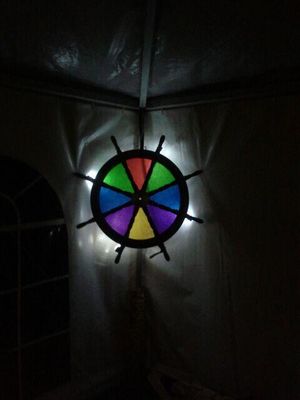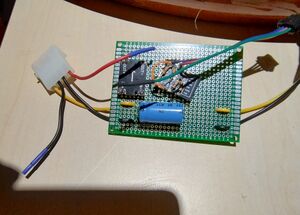Techinc Wheel: Difference between revisions
→Recent code: Fix code formatting |
No edit summary |
||
| (One intermediate revision by the same user not shown) | |||
| Line 18: | Line 18: | ||
* The Wheel is on wifi, as 'ti-wheel.local' | * The Wheel is on wifi, as 'ti-wheel.local' | ||
* The wheel is connected to our HomeAssistant instance on https://spass.techinc.nl: device light.techinc_wheel | * The wheel is connected to our HomeAssistant instance on https://spass.techinc.nl: device light.techinc_wheel | ||
* The old arduino which ran the wheel before is | * The old arduino which ran the wheel before is attached to the power supply, in case a revert is ever needed. | ||
Feel free to add/suggest extra code to the ESPhome settup, add sensors or whatever. | Feel free to add/suggest extra code to the ESPhome settup, add sensors or whatever. | ||
[http://www.narya.dds.nl/stuff/techinc-wheel.mp4 MOVING PICTURES] | [http://www.narya.dds.nl/stuff/techinc-wheel.mp4 MOVING PICTURES] | ||
[[File:wheelesp.jpg|thumb|the brains of the project]] | |||
The wheel is not connected to [[Powerbars]] | The wheel is not connected to [[Powerbars]] | ||
Latest revision as of 16:55, 16 November 2023
| Projects | |
|---|---|

| |
| Participants | Narya |
| Skills | Electronics, Mechanics |
| Status | Finished |
| Niche | Electronics |
| Purpose | Promotion |
Bringing the wheel to events
If you can't reach Narya or Mariejel, assume a "yes" when you (a techinc member) want to bring the wheel to an event. Please put it back on the wall when the event is over. If the LEDs come loose you can simply put it back with double-sided tape and/or ductape.
Summary
- The wooden techinc wheel has a WS2801 LED strip stuck on the back and is controlled via an
Arduino Nanoesp8266 with ESPHome - The 8 strips consist of 5 pixels each (3 LEDs per pixel). The first "spoke" goes outwards, the second inwards, the third outwards, etc
- The data pin is GPIO4 and the clock pin GPIO2
- Color order is BRG, which is supported by the FastLED library, but for other libraries you need to put the colors in the right order
- The Wheel is on wifi, as 'ti-wheel.local'
- The wheel is connected to our HomeAssistant instance on https://spass.techinc.nl: device light.techinc_wheel
- The old arduino which ran the wheel before is attached to the power supply, in case a revert is ever needed.
Feel free to add/suggest extra code to the ESPhome settup, add sensors or whatever.

The wheel is not connected to Powerbars
Old Code
Currently the ColorPalette code runs on the Arduino.
Arduino code - work in progress
Things to make and do
This project has several parts: backlit the wheel, mount the wheel to the wall or on some stand, and make the wheel control something. It would be nice to be able to unmount the wheel and take it somewhere else, e.g. to display it at events.
Mount
Who: justa, narya, control-k
Location: on the wall - done- Location: infront of the window - Done

Painting
- NO color painting!
- Scratched parts could eventually be fixed with varnish
Backlit
Who: Narya, Brainsmoke and Mariejel
Who, later: Justa who moved it to ESPHome
Soldering: done
WS2801 12V magic strip
- 12V
- 40 addressable pixels, color profile BRG
- Wires: green 12V (not attached), blue clock (
pin 11GPIO02), red data (pin 12GPIO04), black GND (pin GND)
Color patterns
- Make a few color patterns:
- No rotation: colors of logo
- From center to outside and vice versa (knight rider)
- Rainbow glow - Done
- Rotating colors - Done
- FIRE - Done
- Twinkle - Done
Sensors
- Color sensor to change knight rider color for example
- Distance sensor: change color and/or speed. If hand is within 4cm it can function as a switch (switch between color programs)
Software
- FastLED library http://fastled.io/
- Neopixel library https://github.com/adafruit/Adafruit_NeoPixel
- Adafruit_WS2801 https://github.com/adafruit/Adafruit-WS2801-Library
- FastSPI library https://code.google.com/p/fastspi/
- ShiftPWM http://www.elcojacobs.com/using-shiftpwm-to-control-led-strips-with-arduino/
- Related projects @techinc: LEDLightDistrict, Neopixel
Old
Recent code
The most recent code should be on the ESPHome plugin of Home Assistant. Below is a copy of the code as it is on 2023-10-19, for informative purposes.
substitutions:
devicename: ti-wheel
friendly_name: TI Wheel
device_description: ESP12E TI Wheel Profile
project_name: "Espressif.ESP12E"
project_version: "ESP12E TI Wheel by Justa"
# ${friendly_name}
esphome:
name: $devicename
comment: ${device_description}
project:
name: ${project_name}
version: ${project_version}
on_boot:
priority: 600
then:
light.turn_on:
id: 'ti_wheel'
effect: 'Rainbow'
esp8266:
board: esp12e
framework:
version: 2.7.4
wifi:
ssid: !secret wifi_ssid
password: !secret wifi_password
fast_connect: True
# use_address: [REDACTED]
# enable_mdns: True
# Enable fallback hotspot (captive portal) in case wifi connection fails
ap:
ssid: "${friendly_name} Fallback Hotspot"
password: !secret hotspot_password
captive_portal:
# Enable logging
logger:
# Enable Home Assistant API
api:
encryption:
key: !secret api_key
#password: !secret api_password
reboot_timeout: 0s
ota:
password: !secret ota_password
safe_mode: True
web_server:
port: 80
# local: true
auth:
username: !secret web_user
password: !secret web_password
light:
- platform: fastled_spi
name: "Techinc Wheel"
id: "ti_wheel"
chipset: WS2801
data_pin: GPIO4
clock_pin: GPIO2
num_leds: 40
rgb_order: BRG
effects:
- addressable_rainbow:
name: Rainbow
speed: 10
width: 40
- strobe:
name: Strobe1
colors:
- state: true
brightness: 100%
red: 100%
green: 90%
blue: 0%
duration: 500ms
- state: false
duration: 250ms
- state: true
brightness: 100%
red: 0%
green: 100%
blue: 0%
duration: 500ms
- addressable_twinkle:
name: Twinkle
twinkle_probability: 5%
progress_interval: 4ms
- addressable_lambda:
name: "Fire"
update_interval: 15ms
lambda: |-
int Cooling = 55;
int Sparking = 110;
// Adjust size of array to length of pixels
static byte heat[40];
int cooldown;
// Step 1. Cool down every cell a little
for( int i = 0; i < it.size(); i++) {
cooldown = random(0, ((Cooling * 10) / it.size()) + 2);
if(cooldown>heat[i]) {
heat[i]=0;
} else {
heat[i]=heat[i]-cooldown;
}
}
// Step 2. Heat from each cell drifts 'up' and diffuses a little
for( int k= it.size() - 1; k >= 2; k--) {
heat[k] = (heat[k - 1] + heat[k - 2] + heat[k - 2]) / 3;
}
// Step 3. Randomly ignite new 'sparks' near the bottom
if( random(255) < Sparking ) {
int y = random(7);
heat[y] = heat[y] + random(160,255);
}
// Step 4. Convert heat to LED colors
for( int Pixel = 0; Pixel < it.size(); Pixel++) {
// Scale 'heat' down from 0-255 to 0-191
byte t192 = round((heat[Pixel]/255.0)*191);
// calculate ramp up from
byte heatramp = t192 & 0x3F; // 0..63
heatramp <<= 2; // scale up to 0..252
// figure out which third of the spectrum we're in:
//this is where you can reverse the effect by switching the commented out lines in all 3 places.
if( t192 > 0x80) { // hottest
//it[it.size() - Pixel - 1] = ESPColor(255, 255, heatramp);
it[Pixel] = ESPColor(255, 255, heatramp);
} else if( t192 > 0x40 ) { // middle
//it[it.size() - Pixel - 1] = ESPColor(255, heatramp, 0);
it[Pixel] = ESPColor(255, heatramp, 0);
} else { // coolest
//it[it.size() - Pixel - 1] = ESPColor(heatramp, 0, 0);
it[Pixel] = ESPColor(heatramp, 0, 0);
}
}
button:
- platform: restart
name: "${friendly_name} Restart Button"
switch:
- platform: restart
name: "${friendly_name} Restart"
- platform: safe_mode
name: "${friendly_name} Restart (Safe Mode)"
- platform: shutdown
name: "${friendly_name} Shutdown"
binary_sensor:
- platform: status
name: "${friendly_name} Status"
sensor:
- platform: uptime
name: "${friendly_name} Uptime"
id: uptime_sensor
update_interval: 30s
on_raw_value:
then:
- text_sensor.template.publish:
id: uptime_human
state: !lambda |-
int seconds = round(id(uptime_sensor).raw_state);
int days = seconds / (24 * 3600);
seconds = seconds % (24 * 3600);
int hours = seconds / 3600;
seconds = seconds % 3600;
int minutes = seconds / 60;
seconds = seconds % 60;
return (
(days ? String(days) + "d " : "") +
(hours ? String(hours) + "h " : "") +
(minutes ? String(minutes) + "m " : "") +
(String(seconds) + "s")
).c_str();
text_sensor:
- platform: template
name: "${friendly_name} Human Uptime"
id: uptime_human
icon: mdi:clock-start
- platform: version
name: "${friendly_name} Version"
icon: mdi:new-box
hide_timestamp: True
- platform: wifi_info
ip_address:
name: "${friendly_name} IP Address"
icon: mdi:ip-network-outline
Old Arduino inmplementation
#include <SPI.h>
void setup()
{
SPI.begin();
SPI.setBitOrder(MSBFIRST);
SPI.setDataMode(SPI_MODE0);
SPI.setClockDivider(SPI_CLOCK_DIV8);
}
uint8_t fade[] =
{
//[ int(((.5-cos(2*pi*x/240.)*.5)**2.2)*255) for x in range(240) ]
0,0,0,0,0,0,0,0,0,0,0,0,0,0,0,0,0,0,0,0,0,0,1,1,1,1,2,2,2,3,3,4,4,5,6,7,7,8,9,10,12,13,14,16,17,19,20,22,24,26,28,30,33,35,38,40,43,46,49,52,55,58,62,65,69,72,76,80,84,88,92,96,100,104,108,113,117,121,126,130,135,139,144,148,153,157,162,166,171,175,179,184,188,192,196,200,204,208,211,215,218,222,225,228,231,234,236,239,241,243,245,247,248,250,251,252,253,254,254,254,255,254,254,254,253,252,251,250,248,247,245,243,241,239,236,234,231,228,225,222,218,215,211,208,204,200,196,192,188,184,179,175,171,166,162,157,153,148,144,139,135,130,126,121,117,113,108,104,100,96,92,88,84,80,76,72,69,65,62,58,55,52,49,46,43,40,38,35,33,30,28,26,24,22,20,19,17,16,14,13,12,10,9,8,7,7,6,5,4,4,3,3,2,2,2,1,1,1,1,0,0,0,0,0,0,0,0,0,0,0,0,0,0,0,0,0,0,0,0,0
};
uint8_t r=0,g=80,b=160;
void loop()
{
for(;;)
{
r+=1;g+=1;b+=1;
for (i=0; i<40; i++)
{
r+=6;g+=6;b+=6;
if (r >= 240) r-= 240;
if (g >= 240) g-= 240;
if (b >= 240) b-= 240;
SPI.transfer(fade[r]);
SPI.transfer(fade[g]);
SPI.transfer(fade[b]);
}
delay(20);
}
}